
The First Liners of Norwegian Amerika Line
![]()
 Den Norske Amerikalinje (NAL) was established on 27th August 1910 to give Norwegian citizens a direct steamship service between Kristiania (Oslo) and New York. This was almost a century after the first Norwegian steamship line had been formed in 1827, and forty years after a direct service was operated from Bergen to New York in 1871 by a Bergen shipowner, the service failing after five years. In the interim period, Norwegian Transatlantic passengers took a steamer to Copenhagen, Hamburg or Newcastle to transfer to larger passenger steamers for their voyage to New York. Two sister twin funnelled passenger steamers of 10,699grt were ordered from the Birkenhead yard of Cammell Laird & Co. Ltd. at the end of 1911 for delivery in May and September 1913 with accommodation for 1,100 passengers in three classes as Kristianiafjord and Bergensfjord.
Den Norske Amerikalinje (NAL) was established on 27th August 1910 to give Norwegian citizens a direct steamship service between Kristiania (Oslo) and New York. This was almost a century after the first Norwegian steamship line had been formed in 1827, and forty years after a direct service was operated from Bergen to New York in 1871 by a Bergen shipowner, the service failing after five years. In the interim period, Norwegian Transatlantic passengers took a steamer to Copenhagen, Hamburg or Newcastle to transfer to larger passenger steamers for their voyage to New York. Two sister twin funnelled passenger steamers of 10,699grt were ordered from the Birkenhead yard of Cammell Laird & Co. Ltd. at the end of 1911 for delivery in May and September 1913 with accommodation for 1,100 passengers in three classes as Kristianiafjord and Bergensfjord.
Kristiania (Oslo) was founded in 1048, with Norway later formally linked to the Swedish crown and declared its independence in 1905. The union with Sweden was peacefully dissolved and the Norwegians elected their own monarch, Prince Karl of Denmark, who took the title of King Haakon of Norway, and he reigned until his death in 1967. The entire city of Kristiania was renamed Oslo on 11th July 1924 after much debate in and around the area, effective from 1st January 1925. Oslo has since grown to encompass an area of 426 square kilometres with a population of 659,000 in 2016, but has a much larger population in the greater metropolitan area of 1.71 million people.

Design and Specification of the Sisters
The naval architects designed the two sister liners with five holds, two lower complete steel decks, a shelter deck, and a third deck in numbers one, two and five holds, and divided by eight bulkheads, with a long Promenade Deck and Upper Promenade Deck in the raised superstructure. The hull dimensions were a length of 512.4 feet, moulded beam of 61.2 feet and depth of 29.4 feet, with a fo’c’stle of length 108 feet, bridge deck of length 201 feet and poop deck of length 80 feet. The cellular double bottom aft was of length 119 feet, under the engine room and boilers it was 152 feet, and under the forward holds it was of length 189 feet with a total capacity for 1,165 tons of ballast and fresh water. They were given flat keels with a fore peak of capacity 149 tons and aft peak of capacity 150 tons.
They were designed with a pronounced counter stern, two tall raked masts and two tall raked steam funnels, and cargo derricks that served as ventilators for the cramped conditions of the steerage passengers in 132 cabins on the Main Deck and 104 cabins on Upper Main Deck above. The 760 Steerage passengers were housed in very small four and six berth cabins with only one wash basin and mirror in each cabin, and communal toilets right aft over the counter stern, females to port and males to starboard. There was also the possibility of the smell of lubricating oil permeating onto these two decks from the close proximity of machinery in the engine room below. Passengers were willing to put up with this and the cramped accommodation arranged around the trunked hatchways to the five holds for the short period of the voyage in the hope of a new and better life and a fresh start in New York.

The Promenade Deck and Upper Promenade Deck had accommodation for 105 First Class passengers, all in better ventilated outside cabins. In addition, there were two de luxe cabins with en-suite facilities on the Upper Promenade Deck, each comprising a large sitting room, bedroom, private bath and toilet, with luxury that would be commonplace in the cruise liners of today. The First Class Dining Room was well ventilated and extended to the full width of the vessels, with all First Class passengers dining in one sitting at tables for two or four passengers. The Dining Room was tastefully decorated in white and gold with wooden art panels of Norwegian scenery. The Main Lounge, Music Room, Reading and Writing Rooms were equally handsomely decorated and located on the Promenade Deck, with the Smoking Room on the Upper Promenade Deck finished in Australian oak, with many cosy alcoves, and a Veranda Cafe adjoining this room with outside views to the stern. The spacious Promenade Decks were ideal for deck quoits and other games, and for promenading in the fresh air.
The 216 Second Class passengers had their cabins on the Shelter Deck ‘midships, which were all well ventilated and well furnished for two or four passengers per cabin. The Second Class Dining Room was aft with seating for 120 passengers, thus necessitating two sittings, and was finished in polished birch and highly decorated with artistic wooden panels. The Second Class Music Room and Smoking Room were located on the Promenade Deck. In contrast, the Third Class or Steerage Dining Room was ‘midships on Upper Main Deck and was provided with two dozen long tables for communal dining. A pantry, and rooms for the serving maids were in the centre of this dining room, arranged around the trunked engine exhausts, with many of the crew housed forward on this deck to port and starboard of the centrally placed Mail Room. The Main Deck below had refrigerated rooms for the food as well as stores of rum for the crew and baggage rooms for passenger luggage, all arranged around the trunked engine exhausts.
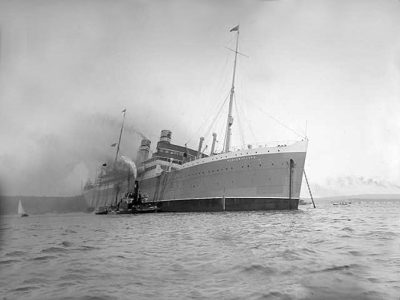
The sisters were powered by twin coal fired steam quadruple expansion engines, the coal being shovelled into 32 corrugated furnaces and eight single ended boilers with a grate surface of 590 square feet with forced draught to give a heating surface of 23,000 square feet. The twin Birkenhead built engines drove twin propellers to give a service speed of 15 knots, and a speed in excess of this on the measured mile. Captain Irgens was the first Master of Bergensfjord when she was delivered in September 1913, four months after Kristianiafjord had been accepted into service. The launch dates for the sisters were 23rd November 1912 for Kristiania-fjord (Yard number 784), and 8th April 1913 for Bergensfjord (Yard number 787).
The First Nal Liners In Service
Kristianiafjord made her maiden voyage on 4th June 1913 from Kristiania, calling at Bergen three days later before sailing on to New York. King Haakon VII and several Norwegian Government officials made the voyage between the two Norwegian ports, such was the importance of the new NAL sisters. Bergensfjord made her maiden voyage on 27th September 1913, and Kristianiafjord and Bergensfjord were photographed together anchored in the Puddefjorden off Bergen later in 1913, probably the only time that it is thought they were together in company in service. The pair were very successful in their first years, taking a lot of passenger trade away from the DFDS Scandinavia America Line with three passenger liners of 10,100grt built by the Linthouse yard of Alexander Stephen & sons Ltd. in Oscar II, Helig Olav and United States during 1902/03.
Kristianiafjord unfortunately had a very short career of only four years until she sailed from New York on her last voyage in May 1917. The course was a northern Great Circle off Newfoundland, arcing up to Greenland, but due to a navigational mistake she ran aground on the isolated south eastern tip of the Avalon peninsula in Newfoundland. This is called Mistaken Point or Cape Race and was also the site of the first Transatlantic wireless station to be built in Newfoundland in 1904. She had on board 1,144 passengers and crew and 3,740 tonnes of general cargo, with all on board safely taken off the ship by her own lifeboats and landed ashore near the Cape Race lighthouse. The wreck of the first NAL liner was destroyed during a storm on 28th July 1917 before refloating could be attempted.

Norway remained neutral during World War I, and the Transatlantic passenger service made handsome profits as it was considered a safer way to cross the Atlantic than in ships of the two warring European countries. Bergensfjord then sailed with a new partner on the Transatlantic service from Kristiania, calling at Kristiansand, Stavanger and Bergen before crossing to New York, from February 1918 in the slightly larger Stavangerfjord of 12,977grt, again from the Birkenhead yard of Cammell Laird & Co. Ltd. as Yard number 821. Stavangerfjord had accommodation for 88 First Class passengers, 318 in Second Class and 820 in Third or steerage. She was later converted to a Cabin Class liner with 147 passengers in superior Cabin Class, 207 passengers in Tourist Class, and the same number in Third Class or steerage. She was a big improvement over Kristianiafjord and Bergensfjord with an extra deck in her ‘midships accommodation, as well as a cruiser spoon stern, two wider funnels and two masts with derricks serving six holds carrying up to 7,500 tonnes of cargo.
Bergensfjord and Stavangerfjord went cruising from the summer of 1925 to the North Cape, Baltic ports and ports in the United Kingdom, Ireland and Europe, a practice that continued throughout the Depression when Transatlantic passengers were few in number The profile of Bergensfjord was later altered in a refit in 1932 by modifying her Promenade Deck and extending it to the Poop Deck by plating over the space above numbers four and five hatches in an effort to match the appearance of her larger and better partner. The navigating bridge was heightened, and her lifeboat arrangement ‘midships was also modified, and an extra two lifeboats were mounted on the Poop Deck. This raised her gross tonnage to 11,015, and the refit also added two low pressure steam turbines to improve her service speed to seventeen knots. She had also been converted into a Cabin Class liner by two alterations to her internal cabin layout in November 1925 and September 1927 with 90 passengers in superior Cabin Class, 155 in Tourist Class, and 500 in Third Class.
Bergensfjord and Stavangerfjord sailed throughout the inter-war years on their nine day Transatlantic single voyage schedules, only interrupted when Bergensfjord was beached after a serious engine room explosion shortly after sailing from Bergen on 26th July 1924. She had a bad list to port and resumed her Transatlantic service after two months of repairs. A third motor passenger liner entered service in May 1938 for NAL as Oslofjord from the Deutsche Schiff und Maschinenbau yard at Bremen. She had accommodation for 860 passengers with 152 in Cabin Class, 307 in Tourist Class and 401 in Third Class, but was unfortunately lost on 1st December 1940 when damaged by an acoustic mine off the south pier while waiting to enter the Tyne for conversion into a troopship. The liner was still upright and sitting partially out of the water, but the fore end capsized during the night of 21st to 22nd January 1941 and she was a total loss. A Chandris of Greece general cargo ship carrying ammunition was also mined off the Tyne later in the war and exploded, and sank on top of Oslofjord, thus destroying most of her remains, which were dispersed at the end of the war.
World War Ii Service Of Bergensfjord
Bergensfjord had been converted into a two class ship in January 1939, dispensing with the Tourist or Second Class, and carrying only First and Third Class passengers. On the invasion of Norway by Germany on 9th April 1940, Bergensfjord and Oslofjord were fortunately at New York and were able to sail for the Allied war effort, while Stavangerfjord was captured by Germany at Oslo and served as a troop depot ship throughout the war at that port. Bergensfjord was laid up at New York on 15th April 1940 at the end of her nine day voyage that had begun at Bergen on 7th April, until requisitioned in November 1940 by the Ministry of War Transport. She sailed from New York on 9th November 1940 at Halifax (NS) for some preparatory work for conversion into a troopship, before she sailed from Halifax (NS) on 9th December 1940 for Liverpool, where she was fully converted into a troopship over the following two months. She was then managed by Furness Withy & Co. Ltd. for the next five years of arduous troopship service.
The first troop ship voyage with 2,100 troops began at Glasgow on 7th February 1941 to Freetown in convoy WS6A, in company with a dozen troopships and some cargo ships, reaching the West African port on 2nd March. Six days later, she sailed for Cape Town and Durban in convoy WS6 arriving in the Natal port on 26th March. She then sailed independently for Aden arriving 20th April and moved up the Red Sea to Suez, where she disembarked her British troops and embarked 1,700 Italian prisoners of war, guarded by 134 Indian troops, and sailed for Durban in convoy SW6 on 1st May, arriving in the South African port fifteen days later to disembark the prisoners. She then sailed from Durban independently for Freetown, arriving on 13th June to embark more troops for Durban, where she arrived on 4th July in convoy WS9A. She then sailed independently for the Clyde via a circuitous route of Cape Town, Trinidad, St. John (NB), arriving in Scotland on 22nd August 1941.


She then made four return voyages with troops from the Clyde to Iceland, and then sailed for Halifax (NS) two days before Christmas Day 1941 in convoy CT8 and arrived on 1st January 1942. She embarked Canadian troops for the Clyde and sailed in convoy NA1, and then sailed from the Clyde on 16th February 1942 for Freetown, arriving in the West African port on 1st March in convoy WS16. She continued in the same convoy on to Cape Town and East Africa, but the convoy split on 3rd April and she arrived at Aden three days later. She then sailed independently to Suez, where she embarked 1,500 prisoners of war and 370 troops for Durban, arriving in the South African port on 23rd April. She then sailed independently for the Clyde by way of Freetown, arriving at Greenock on 7th June to embark more troops for Freetown, Cape Town and Aden in convoy WS20. The convoy split on 1st August and Bergensfjord arrived at Aden after 8 days, and she then sailed independently for Suez, and back to Aden before carrying troops to Basra for the defence of British oilfields.
She arrived independently and arrived at Durban on 13th September 1942, before sailing for Matadi, Lagos, Bathurst and Freetown, and carried on independently to the Clyde, where she arrived on 4th November 1942. She then embarked troops for Operation Torch, the invasion of North Africa, making two voyages in convoy to Algiers, and then sailed independently from Gibraltar to Casablanca, arriving on 22nd January 1943. She then moved down to Freetown to embark West African troops at Takoradi and Lagos for transport to Freetown, and sailed from there for Cape Town in convoy WS27, and then carried on up the East African coast to Kilindini (Mombasa) in the same convoy to arrive in the East African port on 4th April 1943. She then sailed independently for Suez to embark prisoners of war and guard troops for Durban, and returned to Suez in convoy WS29 via Aden to prepare for Operation Husky, the invasion of Sicily.
She sailed from Port Said with 871 troops in convoy MWF36 and arrived off the landing beach at Beach George amid several air attacks in south east Sicily on 10th July 1943. She witnessed the sinking of the British India Line hospital ship Talamba and took on board some of her survivors. After Syracuse was secured, the remainder of her Royal Navy personnel were disembarked, and she sailed unescorted back to Valletta and Alexandria, and loaded more troops for Augusta in Sicily and sailed in convoy MWF38, arriving there on 24th July. She arrived back at Port Said in convoy MEF38, collected troops at Suez and then sailed in convoy MKF22 for Algiers, Gibraltar and the Clyde, arriving at the Scottish port on 9th September 1943. She then embarked troops for Philippeville in North Africa and sailed in convoy KMF24, arriving on the return voyage at Gibraltar in convoy MKF24. She then sailed south to Freetown and returned to Gibraltar to participate in the Indian convoy KMF25 by way of Port Said, Aden and Bombay, the Mediterranean being less dangerous after the surrender of Italy. She returned from Bombay independently to Suez and Port Said, from where she sailed in convoy XIF6 to Taranto and Philippeville and then sailed north to the Clyde in convoy MKF27, where she arrived on 4th January 1944.
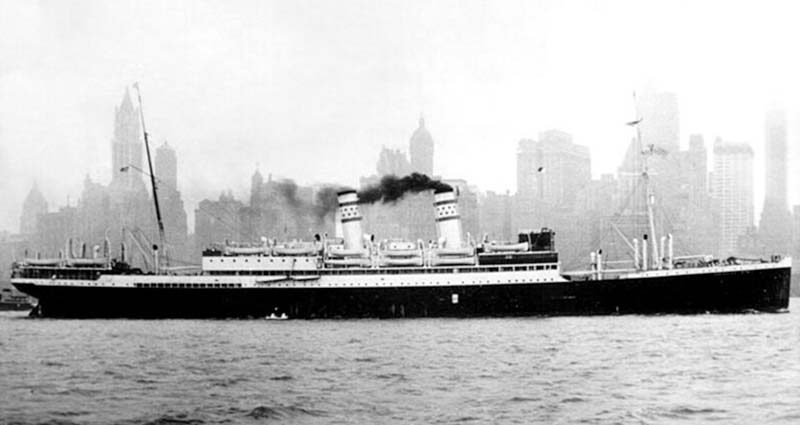
The trooping voyages of Bergensfjord during 1944 were from the Clyde to New York and to Naples, and included a 93 day refit in Glasgow to repair the ravages of long war service on her hull and give her a fresh coat of black paint. After arriving in Naples on 17th November 1944, she carried out a series of Mediterranean trooping voyages to Oran, Toulon, Taranto, Piraeus, Volos, Haifa and Port Said that kept her busy until she sailed from Port Said on 7th February 1945 for Gibraltar and the Clyde in convoy MKF39, arriving back at Glasgow on 20th February 1945. She then embarked 1,688 troops and sailed in convoy KMF41 for Port Said, and again carried out a number of Mediterranean voyages to Gibraltar, Malta, and Marseille, with three return voyages from Marseille to Odessa, repatriating Russian prisoners of war in one direction and Allied prisoners of war in the other direction. The war in Europe ended on 8th May 1945, and Bergensfjord returned to Glasgow and Leith at the end of that month. She returned to her native Norway in June 1945 for the first time in five years to change her Norwegian crew, but her wartime trooping was not yet over and she made a ‘Round Africa’ voyage to Toulon, Port Said, Colombo, Kilindini, Durban, Freetown, Takoradi and Gibraltar. The crew were very happy to celebrate Christmas at her home port of Oslo, arriving there on 19th December 1945.
Bergensfjord had carried a magnificent total of 165,000 troops and sailed 300,000 miles during her arduous war service, with her sea time having clocked up to 919 days. She made another voyage under charter in February 1946 to carry the brides of American GI troops from Europe to the United Sates, and was then returned to NAL ownership.
Bergensfjord as the Zim Liner Jerusalem
Bergensfjord was laid up at Oslo until August 1946, when a decision was made by the NAL directors not to recondition her for peacetime service, but to sell her instead. The buyer was Panamanian Lines Inc. of Fratelli Cosulich of Trieste, which had been set up by Callisto Cosulich, the first Cosulich brother, in 1902 and which had become part of Italia Line in 1937. The NAL liner was renamed Argentina for emigration voyages from Italy to South America. She was modified in 1949 to take 126 First Class passengers, 250 in Second Class and 574 in Third Class, and returned to the popular Genoa to South American ports route in September of that year. She was transferred to the North American trades in 1951 from Italian ports, but sold in the following year to Home Lines of Italy without change of name.
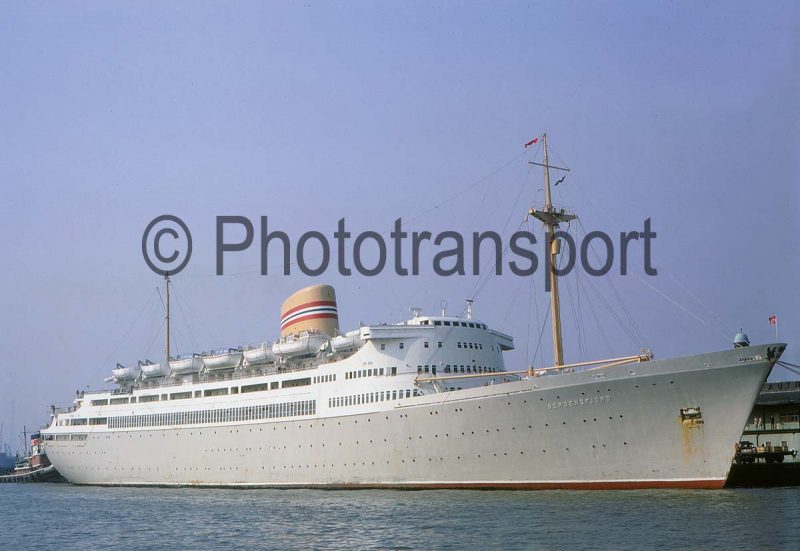
In 1953, the former Bergensfjord was sold to the fledgling Zim Lines of Israel and renamed Jerusalem for voyages between Haifa and New York. David Ben-Gurion had read out the Declaration of the State of Israel on 14th May 1948 at the Tel Aviv Museum, and he formed his first Cabinet of Ministers of the new State of Israel on 10th March 1949 with himself as Prime Minister. Zim Israel Navigation Co. Ltd. was formed on 15th August 1948 in Haifa, and concentrated in the first five years on cargo services in the Mediterranean, the Black Sea, North West Europe and to Canada, the Gulf of Mexico and the United States. Jerusalem was modified with only 38 passengers in First Class and 741 passengers in Third Class, and commenced Transatlantic sailings to New York on 29th April 1953 calling at Piraeus, Malta, Ceuta and Halifax (NS). She made eleven round voyages from Haifa to New York by 1955, when with the delivery of four new Deutsche Werft of Germany built liners she was switched to the Haifa to Marseille run. In 1957, the former Bergensfjord was renamed for the last time as Aliya, Hebrew for ‘Jewish Immigration’, and then laid up in May 1958 at Haifa until she was sold for scrapping in August 1959 to Terrestre Marittima of La Spezia after a long career of 46 years. She had proudly worn her twin white funnels with seven yellow stars between two blue bands, and with a black hull, for six years.
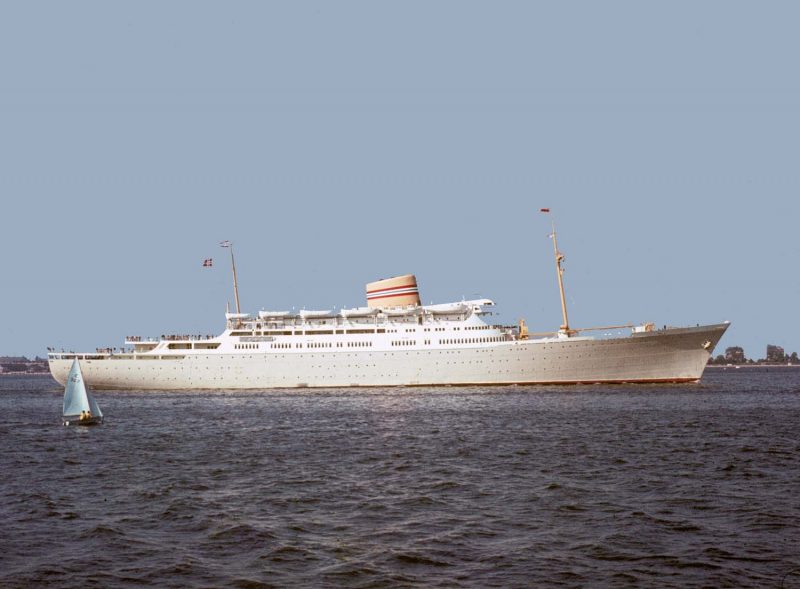
Zim Lines continued their passenger services to New York calling at Naples, Palma, Malaga, Gibraltar, Ceuta and later Ponta Delgada in the Azores, as well as to Buenos Aires via Madeira, Las Palmas, Rio de Janeiro, Santos and Montevideo. The German built quartet of Israel, Zion, Jerusalem (2), and Theodor Herzl were used for these services, the latter vessel named after the founder of political Zionism. Theodor Herzl was an Hungarian born Jew, but he grew up in Vienna and opened the first Zionist Congress in Basle in August 1897, seven years before his death. The Zim Lines passenger flagship was the beautiful liner Shalom (‘Peace’) of 25,320grt completed in March 1964 by the Chantiers de l‘Atlantique at Saint Nazaire with accommodation for 1,090 passengers in two classes and a crew of 470. She lasted only three years in the Zim Lines fleet before her sale in March 1967 to Deutsche Atlantik Line as Hanseatic. Zim Lines continued their passenger services with their German built quartet until they had been sold off by the late 1960s, thus ending their passenger services.
Bergensfjord (2)
A beautiful new NAL liner was launched by Princess of Astrid of Norway on 18th July 1955 at the Wallsend yard of Swan, Hunter and Wigham Richardson Ltd. as Bergensfjord (2). Yard number 1849 was completed in May 1956 and attained a trials speed of 22.1 knots over the Newbiggin measured mile, giving her a service speed of twenty knots, from powerful twin eight cylinder Stork diesel engines of 18,600 bhp at 130 rpm and manufactured by her builders. She had accommodation for 878 passengers with 103 in First Class and 775 in Tourist Class, and a crew of 335. She was a worthy successor to her Birkenhead built namesake, and was designed for both Transatlantic crossings and for cruising. She featured a steeply raked bow, an extensive aluminium alloy superstructure and welded fabrication throughout. She had five complete steel decks, namely ‘A’, ‘B’, ‘C’, ‘D’ and Promenade Deck, and an Orlop Deck outside of the machinery spaces, the after part of this deck provided the crown of the shaft tunnels.
The aluminium alloy superstructure had four decks, and was fastened to the steel deck by means of a series of galvanised bolts with neoprene packing to minimise corrosion. The upper two decks, Sun Deck and Upper Sun Deck, had accommodation for 103 First Class passengers arranged in single, two, three and four berth cabins. These were spacious cabins and furnished with large beds and modern furniture, with an adjoining bathroom and toilet or shower and toilet. Forward on Upper Sun Deck was the central Captain’s Dayroom, with cabins for the Chief Officer and Doctor to port, and the other senior Navigating Officers and Purser to starboard. The accommodation for 775 Tourist Class passengers was also in single, two, three and four berth cabins, but these were much less spacious, with upper Pullman berths that could be folded away when not in use. These also had a private toilet and shower cubicle, with all cabins, irrespective of Class, having two inch air space between double panelling to give good sound proofing, and good use was made of veneers and plastic in the cabins. The spacious wheelhouse on the upper navigating bridge had the chartroom, radio room and pilot room to the rear, with flying bridges to port and starboard.
The public rooms were decorated by Arnstein Arneberg of Oslo, a leading interior designer. The First Class Dining Room, First Lounge and dancing space, First Class Garden Lounge, First Class Smoking Room, First Class Writing Room, and vestibules and bars were decorated in Scandinavian style with much use of tapestries, paintings, light coloured panels and decorative glass panelling.
The First Class Dining Room had the largest hung tapestry, featuring a woven fabric with the chief central motif being the wedding in 1920 of King Haakon V at Akershus Castle in Oslo. The First Class Smoking Room featured paintings of the large Fisherman’s Wharf and market in Bergen and the Bergen City Gate, while the Tourist Class Dining Room featured a large painting entitled ‘Journey of the Dreams’ and large mosaics featuring the joint rulers of Norway and Sweden.
Bergensfjord (2) had main dimensions of overall length of 577.0 feet, 65 feet longer than Bergensford (1), moulded beam of 72.0 feet, depth to ‘B’ deck of 38.6 feet, and loaded draft of 27.6 feet giving a gross tonnage of 18,750 with 100,000 cubic feet of cargo space. She had two holds forward and one aft, together with their associated ‘tween decks, all served by trunked hatchways. Watertight Velle steel hatch covers for the forward hatches, with an aluminium hatch cover for the aft hatch, allowed good watertight protection as well as maximum deck space. Two swimming pools were included, one on the lower passenger deck, and a portable pool situated in number three hatchway on the Sun Deck. A bar was located forward of the permanent pool, and the surrounding areas were ideal for sunbathing on loungers, easy chairs and tub chairs. Passenger lifts connected all of the decks, and the aluminium superstructure for the public rooms, cabins and navigating bridge was fitted with a total of five hundred windows. Fourteen lifeboats, two masts and a nicely rounded funnel bearing the central NAL red, white and blue thin bands completed her aesthetic good looks.
Bergensfjord (2) ran alongside Stavangerfjord of 1918, Oslofjord (3) of 1949 on the North Atlantic between 1956 and 1963, during the golden period of liner travel. Stavangerfjord had been extensively updated during a refit on the Tyne in September 1956, with her Tourist Class accommodation modernised and extended, and a new Social Lounge aft on ‘D’ deck in place of First Class cabins, and new Tourist Class cabins forward in place of the original lounge on ‘E’ deck. She was fitted with Denny Brown stabilisers to make her a very good seaboat during the last seven years of her career, when she became the oldest liner operating on the North Atlantic.
Oslofjord (3) was chartered out in 1969 to Costa Line as Fulvia, but suffered an explosion in her engine room off Tenerife on 19th July 1970. A bad fire flared up ‘midships and all of her passengers and crew took to the boats and were rescued by passing ships. The burning ship was taken in tow for Santa Cruz de Tenerife but she sank about one hundred miles from the island. Bergensfjord (2) and the new Sagafjord of 1965 went cruising for almost all of 1970 with very few Transatlantic crossings.
Bergensfjord (2) was sold in 1971 to French Line and named De Grasse for Caribbean line voyages and for cruising. She was again sold in 1973 to Thoresen & Co.(Singapore) Pty Ltd. and Bruusgaard Kiosterud & Company of Singapore and renamed Rasa Sayang for cruising from Singapore, Malaysia and into the South China Sea. A further renaming to Golden Moon for a Cypriot owner in 1978 was not successful and she was laid up at Piraeus on 11th December 1978. She regained her name of Rasa Sayang for a brief period in 1980 until a very bad fire broke out on 17th August 1980 in her engine room while she was being refitted at Perama and destroyed the interior of the entire ship. She was towed out of Perama and beached near Kynosoura, but she capsized and later disappeared from view. Bergensfjord (1) had a very long career of 46 years, and Bergensfjord (2) a career of 24 years, making a grand total for these two great liners of 70 years.
Postscript
Norwegian Amerika Line traded for 85 years between 1910 and 1995, with the two Bergensfjords afloat for 70 of these years. The line owned passenger liners, general cargo ships, ro-ros, chemical tankers, bulk carriers and car carriers during this time, including seven ships named Kristianiafjord and Bergensfjord.

The traditional passenger trade across the Atlantic from Oslo and Bergen to New York lasted just over sixty years, with the first twin screw mail and passenger liners named Kristianiafjord and Bergensfjord as the most handsome of these notable Norwegian ships.
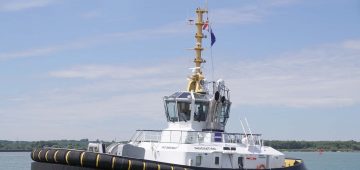



Comments
Sorry, comments are closed for this item